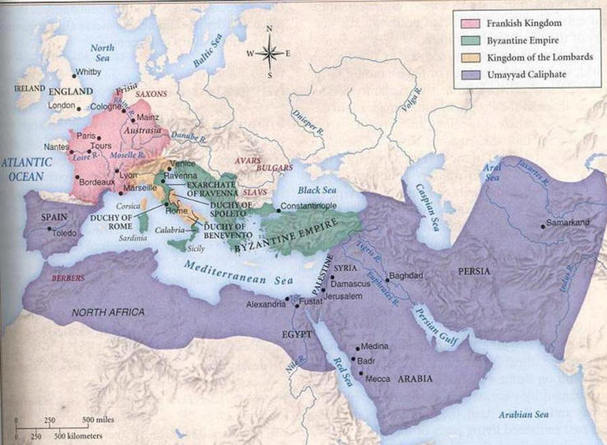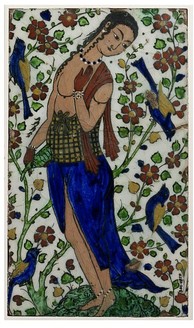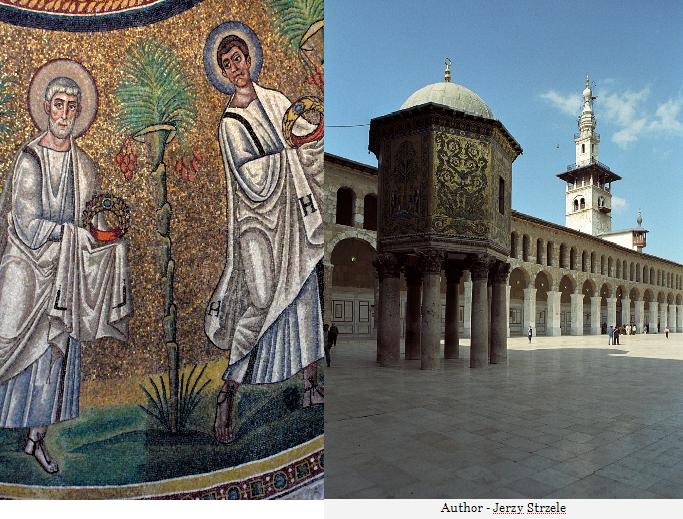Case Study - The Umayyad Dynasty
Tilly Behrmann
Overview
The Umayyad Dyansty - spanning from 661-750 B.C.E. - marked the first Islamic Dynasty after the death of Muhammad. The region encompassed by this dynasty spanned from Arabia to modern day Eastern Iran, and was ruled in hereditary succession. Throughout its existence, the Dynasty experienced significant conquests in Northern Africa, Spain, and Central Asia, thus, spreading the Islamic religion and culture. With this, the Umayyad was marked by a distinct Arab military aristocracy. Despite its wide expanse, the Dynasty's central power remained its impressive capital city - Damascus. Located in Damascus was the Umayyad's central government; however, Damascus also served as a symbol of Islamic culture and influence. Often, this luxurious and extravagant affluence was met with criticism, as it was deemed a threat to Islamic piety. The Shia (who believed that leadership should be determined by hereditary decent from either Ali or Husayn) thought the caliphs of the Umayyad to be illegitimate, as they were not direct descendents of Muhammad. The Umayyad was also met with criticism, as it treated conquered non-Arabs as inferiors. This only augmented the effects of the Battle of Tours (732 C.E.), when the Franks defeated the Islamic Empire, halting further expansion, as well as the spread of Islam into Europe. Eventually, the weakened Umayyad Dynasty fell to the Abbasid Revolution (the Abbasids were the descendents of Muhammad's uncle), thus, signifying the end of the Umayyad Caliphate and the beginning of the Abbasid Caliphate.
The Umayyad Dyansty - spanning from 661-750 B.C.E. - marked the first Islamic Dynasty after the death of Muhammad. The region encompassed by this dynasty spanned from Arabia to modern day Eastern Iran, and was ruled in hereditary succession. Throughout its existence, the Dynasty experienced significant conquests in Northern Africa, Spain, and Central Asia, thus, spreading the Islamic religion and culture. With this, the Umayyad was marked by a distinct Arab military aristocracy. Despite its wide expanse, the Dynasty's central power remained its impressive capital city - Damascus. Located in Damascus was the Umayyad's central government; however, Damascus also served as a symbol of Islamic culture and influence. Often, this luxurious and extravagant affluence was met with criticism, as it was deemed a threat to Islamic piety. The Shia (who believed that leadership should be determined by hereditary decent from either Ali or Husayn) thought the caliphs of the Umayyad to be illegitimate, as they were not direct descendents of Muhammad. The Umayyad was also met with criticism, as it treated conquered non-Arabs as inferiors. This only augmented the effects of the Battle of Tours (732 C.E.), when the Franks defeated the Islamic Empire, halting further expansion, as well as the spread of Islam into Europe. Eventually, the weakened Umayyad Dynasty fell to the Abbasid Revolution (the Abbasids were the descendents of Muhammad's uncle), thus, signifying the end of the Umayyad Caliphate and the beginning of the Abbasid Caliphate.
The Umayyad Legacy: Changes and Continuities
The Umayyad Dynasty is typically remembered negatively throughout history for multiple reasons. Often, it is frowned upon by the Shia, as it represented a false leadership (eventually, it was overtaken by the Abbasids). However, it is also looked down upon because of its endorsement by Osama Bin Laden in the modern century. Despite Bin Laden's wish to revive the Umayyad Caliphate, however, this Dynasty remains a significant symbol of both Islamic culture and historical trends throughout the past millenniums.
One of these continuities is the theme of conquering and expansion. As seen by the Umayyad's expansion across North Africa, Central Asia, and parts of Europe, military conquest played a huge role in the ideals of this empire. With this expansion, the Umayyads created a legacy of cultural diffusion and influence. Throughout history, the motif of conquest is utterly apparent - Charlemagne in Medieval Europe, the Ottoman Empire, and even more recent developments, such as British Imperialism. With this, the theme of cultural unity as a strengthening force is also seen. As the Umayyad Dynasty continued to expand, Islam became a binding force in the empire, making this conquest possible.
However, massive changes also occurred during this time period. For one, Islam became a prominent world power. Although conversion did not play a major role in this dynasty, for the first time, Islam solidified a distinct art form and culture. This is proved by such developments as the Dome of the Rock, which influenced Islamic architecture for years to come. Thus, the legacy of the Umayyad Caliphate can still be seen today, both in its cultural impact, and its shaping of Islam and the entire region of Arabia.
One of these continuities is the theme of conquering and expansion. As seen by the Umayyad's expansion across North Africa, Central Asia, and parts of Europe, military conquest played a huge role in the ideals of this empire. With this expansion, the Umayyads created a legacy of cultural diffusion and influence. Throughout history, the motif of conquest is utterly apparent - Charlemagne in Medieval Europe, the Ottoman Empire, and even more recent developments, such as British Imperialism. With this, the theme of cultural unity as a strengthening force is also seen. As the Umayyad Dynasty continued to expand, Islam became a binding force in the empire, making this conquest possible.
However, massive changes also occurred during this time period. For one, Islam became a prominent world power. Although conversion did not play a major role in this dynasty, for the first time, Islam solidified a distinct art form and culture. This is proved by such developments as the Dome of the Rock, which influenced Islamic architecture for years to come. Thus, the legacy of the Umayyad Caliphate can still be seen today, both in its cultural impact, and its shaping of Islam and the entire region of Arabia.
Works Cited
"Ancient City of Damascus." - UNESCO World Heritage Centre. N.p., n.d. Web. 21 Dec. 2012.
"Heilbrunn Timeline of Art History." The Art of the Umayyad Period (661–750). N.p., n.d. Web. 21 Dec. 2012.
"Internet History Sourcebooks Project." Internet History Sourcebooks Project. N.p., n.d. Web. 21 Dec. 2012.
"Islam, The Arab Empire Of The Umayyads." Islam, The Arab Empire Of The Umayyads. N.p., n.d. Web. 21 Dec. 2012.
"Islamic Art, Music, And Architecture Around The World." Islamic Art, Music, And Architecture Around The World. N.p., n.d. Web. 21 Dec. 2012.
"Ancient City of Damascus." - UNESCO World Heritage Centre. N.p., n.d. Web. 21 Dec. 2012.
"Heilbrunn Timeline of Art History." The Art of the Umayyad Period (661–750). N.p., n.d. Web. 21 Dec. 2012.
"Internet History Sourcebooks Project." Internet History Sourcebooks Project. N.p., n.d. Web. 21 Dec. 2012.
"Islam, The Arab Empire Of The Umayyads." Islam, The Arab Empire Of The Umayyads. N.p., n.d. Web. 21 Dec. 2012.
"Islamic Art, Music, And Architecture Around The World." Islamic Art, Music, And Architecture Around The World. N.p., n.d. Web. 21 Dec. 2012.




